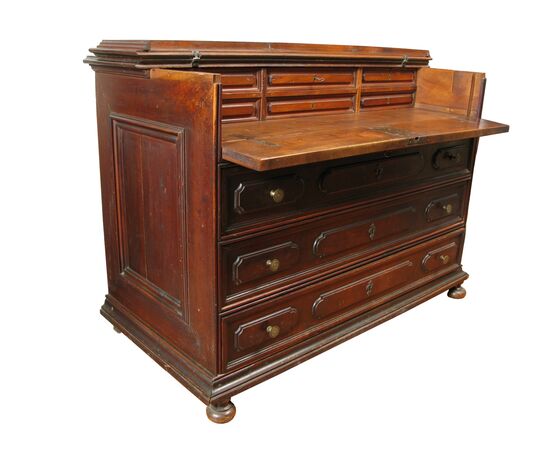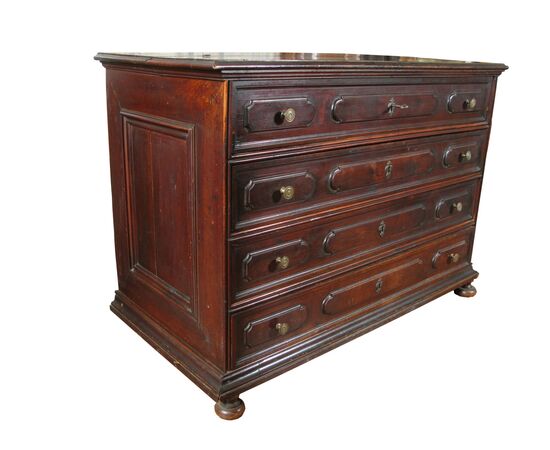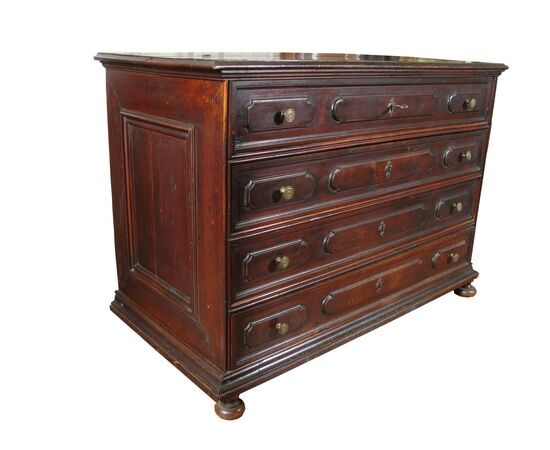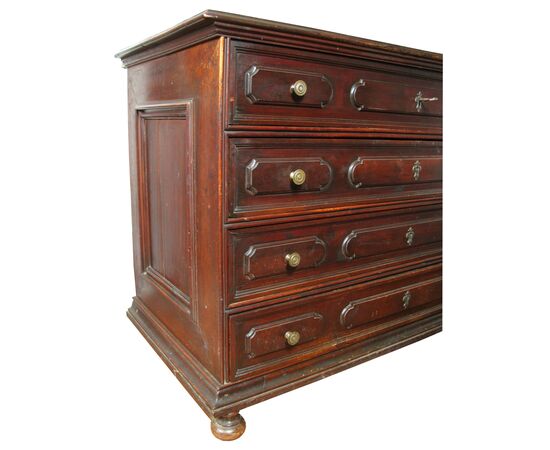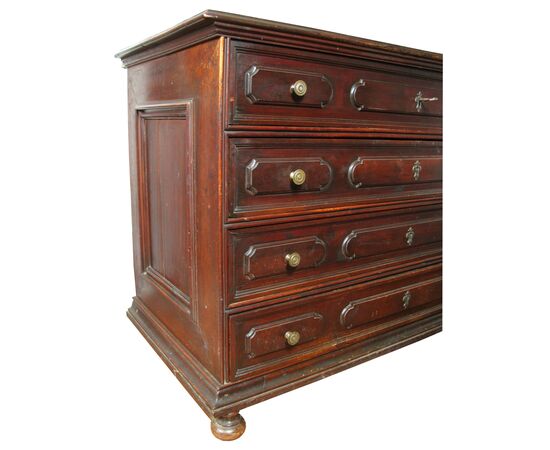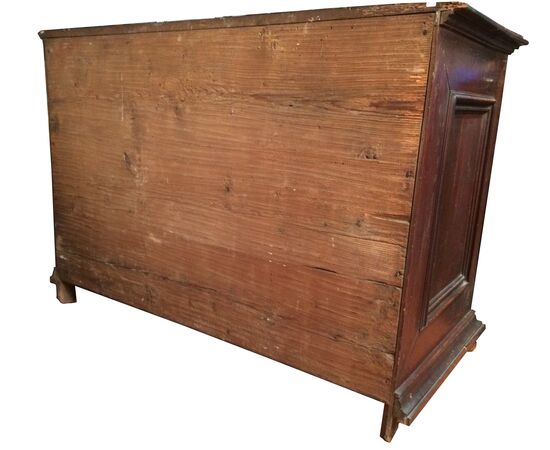Canterano a cassettiera lombardo della fine del XVII° secolo- inizi XVIII° secolo
Fronte suddiviso in quattro cassetti formellati il primo dei quali ha la possibilità di essere abbattuto in avanti celando nell’interno una cassettiera tripartita , formata da sei cassettini formellati e tutti provvisti dell’originale serratura.
Piano in noce, terminante in elegante becco di civetta e suddiviso longitudinalmente in due metà, incernierate tra loro che conferiscono ad esso la possibilità di essere aperto e dare accesso alla cassettiera prima menzionata ed al piano d’appoggio formatisi dal abbattimento del fronte del primo cassetto in posizione orizzontale.
Fianchi riquadrati da mossa corniciatura
Piedi frontali a cipolla schiacciata (tipici del periodo fine XVII - inizi XVIII° secolo)
Il mobile è in perfetto stato di conservazione e presenta una splendida patina originale.
Questa tipologia di canterani, indubbiamente la più preziosa del periodo, erano spesso utilizzati come scrittoi.
Lo spazio che si veniva infatti a formare quando il canterano era “aperto “ diventava un perfetto piano sul quale appoggiarsi per leggere o scrivere.
La misura dei cassettini interni alla cassettiera era spesso calcolata sulla misura dei fogli che dovevano contenere.
Lombardia, fine del XVII° secolo- inizi XVIII° secolo.
Misure: cm 102 x147x71
L’opera, come ogni altro nostro oggetto, viene venduta corredata da attestati di autenticità e lecita provenienza.
Ci occupiamo ed organizziamo personalmente l'imballaggio e la spedizione delle opere d'arte con assicurazione in tutto il mondo
Nel caso l’opera venisse acquistata da clienti non italiani la stessa necessiterà dell’attestato di libera circolazione.
Lo stesso è ottenibile in 10/20 giorni lavorativi.
La galleria si occuperà degli aspetti burocratici ed economici della cosa.
Tutti i costi dell’operazione sono quindi inclusi nel prezzo.
English
Lombard chest of drawers from the end of the 17th century - beginning of the 18th century
Front divided into four paneled drawers, the first of which can be folded forward, concealing a tripartite chest of drawers inside, made up of six paneled drawers all fitted with the original lock.
Walnut top, ending in an elegant owl's beak and longitudinally divided into two halves, hinged together which give it the possibility of being opened and giving access to the aforementioned chest of drawers and to the support surface formed by the demolition of the front of the first drawer in horizontal position.
Sides framed by lively framing
Flattened onion front feet (typical of the late 17th - early 18th century period)
The piece of furniture is in perfect condition and has a splendid original patina.
This type of chest of drawers, undoubtedly the most precious of the period, were often used as writing desks.
The space that was formed when the chest of drawers was "open" became a perfect surface on which to lean to read or write.
The size of the drawers inside the chest of drawers was often calculated on the size of the sheets they were supposed to contain.
Lombardy, late 17th century - early 18th century.
Measurements: 102 x147x71 cm
The work, like all our other objects, is sold accompanied by certificates of authenticity and lawful origin.
We personally take care of and organize the packing and shipping of the works of art with insurance all over the world
If the work is purchased by non-Italian customers, it will require the certificate of free circulation.
The same can be obtained in 10/20 working days.
The gallery will take care of the bureaucratic and economic aspects of the matter.
All costs of the operation are therefore included in the price.
Français
Commode lombarde de la fin du XVIIe siècle - début du XVIIIe siècle
Façade divisée en quatre tiroirs à panneaux dont le premier peut être rabattu vers l'avant, cachant à l'intérieur une commode tripartite composée de six tiroirs à panneaux tous munis de la serrure d'origine.
Dessus en noyer, se terminant par un élégant bec de hibou et divisé longitudinalement en deux moitiés, articulées entre elles qui lui donnent la possibilité d'être ouverte et donnant accès à la commode précitée et à la surface d'appui formée par la démolition de la façade de la première tiroir en position horizontale.
Côtés encadrés par un encadrement animé
Pieds antérieurs à bulbe aplati (typiques de la période fin 17ème - début 18ème siècle)
Le meuble est en parfait état et possède une splendide patine d'origine.
Ce type de commode, sans doute le plus précieux de l'époque, servait souvent d'écritoire.
L'espace qui s'est formé lorsque la commode était "ouverte" est devenu une surface parfaite sur laquelle s'appuyer pour lire ou écrire.
La taille des tiroirs à l'intérieur de la commode était souvent calculée en fonction de la taille des feuilles qu'ils étaient censés contenir.
Lombardie, fin du XVIIe siècle - début du XVIIIe siècle.
Dimensions : 102 x147x71 cm
L'œuvre, comme tous nos autres objets, est vendue accompagnée de certificats d'authenticité et d'origine licite.
Nous nous occupons et organisons personnellement l'emballage et l'expédition des œuvres d'art avec assurance dans le monde entier
Si l'œuvre est achetée par des clients non italiens, elle nécessitera le certificat de libre circulation.
La même chose peut être obtenue en 10/20 jours ouvrables.
La galerie s'occupera des aspects bureaucratiques et économiques de la chose.
Tous les frais de l'opération sont donc inclus dans le prix.

